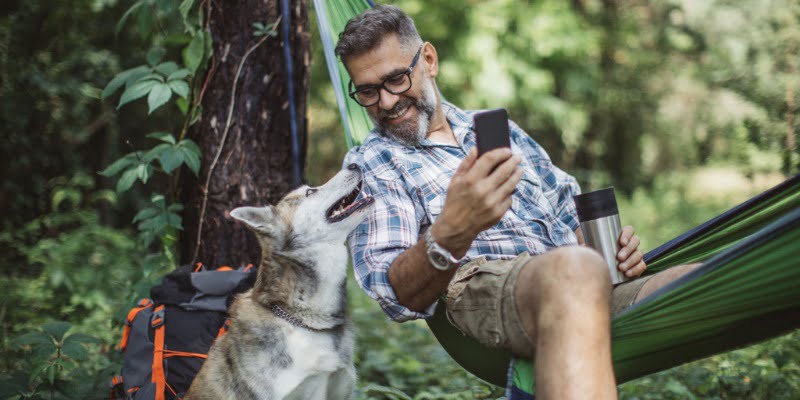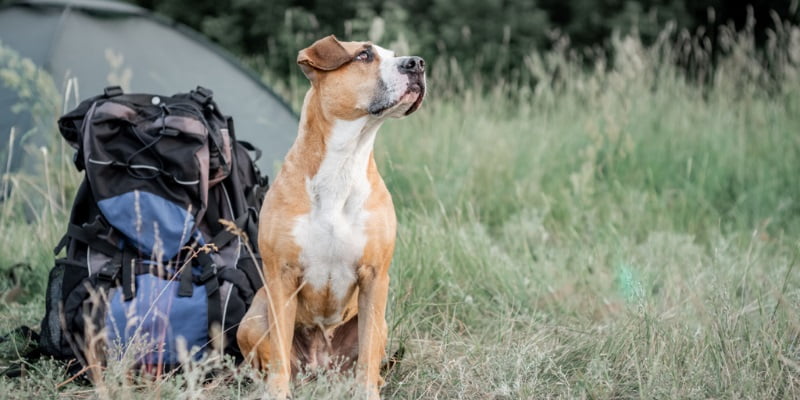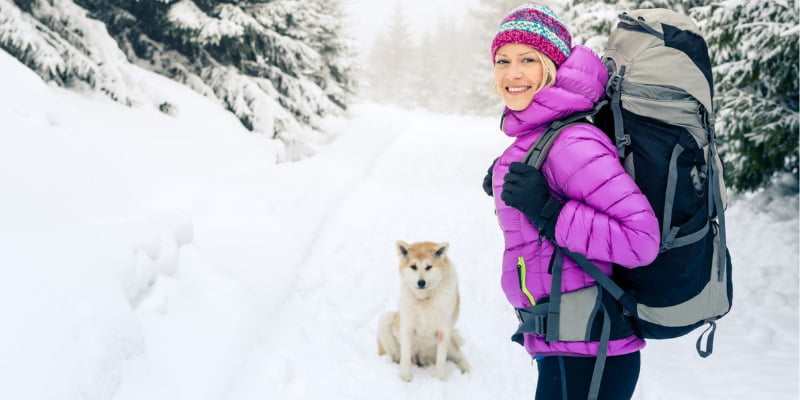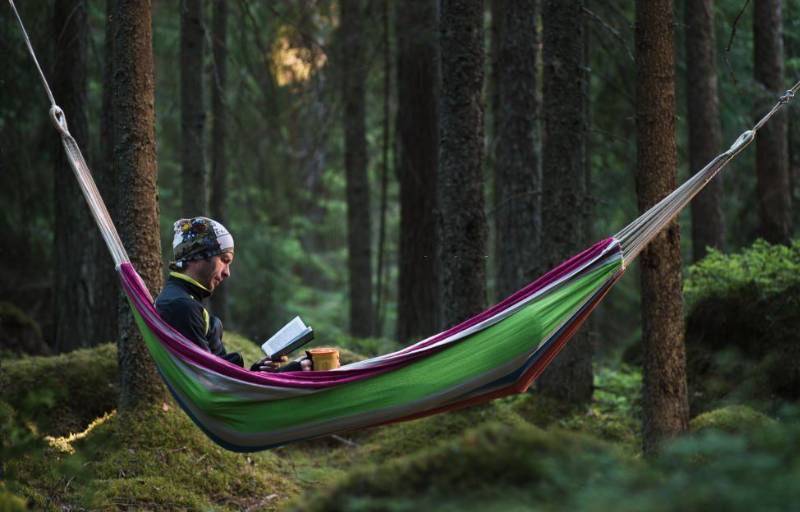13 Tips For Camping With Dogs

Camping with your dog can be a rewarding experience. The wilderness offers a variety of sights, scents, and activities that stimulate your dog’s senses, giving them a special sense of adventure and freedom. To ensure a successful and enjoyable camping trip with your dog, careful planning and consideration are essential. In this guide, I’ll share important tips for camping with your canine companion and highlight key points to keep in mind for a smooth adventure together.
Tips for Camping with Your Dog
Let’s break down the 13 tips for camping with dogs step by step…
1. Securing Dogs While Driving
You have a legal duty to ensure your dog’s safety during travel. The best option is a securely installed dog transport box. This will prevent movement in any direction. Alternatively, custom camper extensions for dogs are recommended but can be more expensive. Avoid transporting your dog in the RV, as you can’t monitor their well-being while in motion.
2. Make Sure Your dog is Allowed on the Campsite
Every dog is usually welcome at campsites, as long as owners follow the rules. However, policies vary by location. It’s essential to check the campsite’s rules during the planning phase to confirm if dogs are allowed in tents or RVs, as restrictions may apply. Always ask before booking.
3. Choose Dog-friendly Camping and Parking Spaces

Finding a campsite that allows dogs doesn’t always guarantee it’s truly dog-friendly. If running space and activities like dog training or walking are important, ask the campsite directly for details before booking. Some campsites may lack specific information, so a little research can help you avoid unpleasant surprises.
Remember, most campsites charge for dogs, and leash rules usually apply everywhere. Even simple things like walking to the restroom with your dog can be challenging. Look for practical features like leash hooks at dog-friendly spots, but stay critical when choosing your vacation spot to ensure a comfortable experience for you and your furry friend.
4. Pay Attention to the Underground of the Campsite
Many campsite operators choose gravel for durability and easy maintenance, but coarse gravel can be tough on your dog’s paws, potentially causing injury. It’s like walking barefoot on rough surfaces—painful and uncomfortable. Look for campsites with grassy areas where your dog can run around freely and comfortably. Plus, you’ll enjoy the experience more without worrying about sore feet!
5. Plan Activities for Camping with Your Dog

As a pet owner, it’s important to take time to relax and enjoy yourself too. Keep in mind that some activities may have limitations when your dog is with you. For example, museums may not allow pets, and certain places might have general restrictions.
To avoid issues, focus on outdoor activities. Want to see a movie? Look for outdoor cinemas that welcome dogs. If you enjoy dining out, research pet-friendly restaurants in advance. While many places allow dogs, not all do, so good research before your trip is essential.
6. Get Your Dog Used to Dog Accessories
While luggage is important, using checklists for your dog is highly recommended. I’ve previously covered useful dog accessories for camping. Let your furry friend get accustomed to new gear. Test items like the dog sleeping bag and peg in a familiar environment before your trip. Familiarity with their equipment can help your dog stay calm in new, stressful situations.
7. Let’s Discuss Where Your Dog Will Sleep

Consider where your dog will sleep while camping, whether in a tent or a motorhome. Options like a sleeping mat with their favorite blanket work well for tents, while a washable dog bed or sofa is ideal for a camper. Make sure the bed is placed out of the way to avoid blocking paths. If your dog is sensitive to new people, designate a cozy sleeping spot in the back. For summer trips, a cooling mat can help keep your dog comfortable.
8. Get Your Dog Used to Your Camping Vehicle

Driving with a dog can be a mixed experience; some love it, while others may be scared or prone to motion sickness. It’s essential to practice car trips before your holiday. Instead of relying on sedatives, create a positive environment in your vehicle or camper. Start by introducing your dog to the vehicle gradually. This will allow them to sniff and explore at their own pace. Once they’re comfortable, include familiar items like toys or blankets. This approach helps them associate the vehicle with positive experiences.
9. Plan the Trip with Your Dog to Your Destination
Camping with a dog requires careful planning, starting with your travel route. Schedule regular breaks at suitable motorway service stations, and use Google Maps to mark and save locations along your route. If you’re inexperienced with camping vehicles, plan conservatively and be aware of potential traffic jams. Keep a calm pace during the drive, and if your dog shows signs of stress, stop in quiet areas for longer breaks. Finally, remain calm to avoid transferring your stress to your dog, as they can sense your anxiety.
10. Avoid Noisy Environment
Dogs often dislike loud, unfamiliar environments, making pet camp tents less suitable for camping. Noise levels can disturb their comfort, so be prepared for restless nights. Provide your dog with a retreat, like a car, where they feel safe. Choose quieter camping areas, away from noisy groups or festivals, and avoid places with loud music or rowdy crowds. Thunderstorms can also be challenging; if you feel uncomfortable, your dog will sense it. In such situations, it’s best to seek refuge in the car until the storm passes.
11. With a Dog in the Tent – This is How It Works

Consider the size of the tent; larger dogs need more space, so opt for a family tent rather than a small one. Confirm that dogs are allowed and check how well-separated dog campers are from others. Although edge sites offer shade and comfort in summer, avoid areas that feel unwelcoming or dirty. Before your trip, familiarize your dog with the tent to reduce stress. Once there, allow your dog time to adjust, keep the tent closed to prevent escapes, and stay calm to help them feel secure.
12. When the Dog Barks on the Campsite
When your dog is barking, it’s essential to understand why. Common reasons include:
- Stress
- Overstimulation
- Lack of attention
- Boredom
- Fear of new environments
- Fear of strangers
- Territorial behavior
Tailor your response based on the cause. For example, if there are too many stimuli, create a quiet retreat for your dog, like the car. If stress is an issue, chewing can help soothe them. Using a privacy screen can reduce barking from unfamiliar passersby. If your dog feels threatened by strangers, consider bringing them inside the RV.
Avoid leaving your dog alone at the campsite for extended periods, as new environments can be stressful. Always plan your activities with your dog in mind, and remember that not all guests may be comfortable with dogs. Walk your dog outside the campsite and don’t pressure yourself to be perfect. Mutual understanding is key to enjoying camping.
Lastly, reward your dog for being calm and quiet, as this reinforces good behavior.
13. Make Checklists for Camping with Dogs
Before you head out on holiday with your dog, create a checklist of tasks to complete, such as shopping, packing, and scheduling vet visits. One essential item is a first-aid kit designed specifically for dogs. If you’re uncertain about how to handle a minor injury, keep an emergency guide accessible with your first-aid kit. A well-stocked first-aid kit for camping with your dog should include:
- Tick protection
- Means for deworming
- Flea agent
- Something against travel sickness
- Against poisoning
- Eye ointment or eye drops
- Diarrhea medication
- Remedies against insect bites and against itching
- Painkiller
- Sedatives
- Disinfectant spray
Conclusion
As we wrap up this guide, remember that a safe and enjoyable camping adventure with your dog starts with thoughtful preparation and attentive care. By following the steps outlined, you’re not just ensuring your furry friend’s safety—you’re also paving the way for a memorable bonding experience. Imagine the joy of sharing starlit nights, exploring scenic trails, and creating lasting memories together! So pack your gear, grab your pup, and get ready for an unforgettable camping trip filled with laughter, exploration, and the warmth of companionship.
Happy camping!






